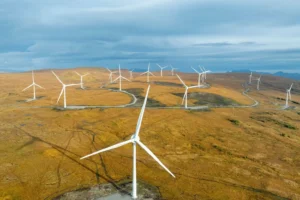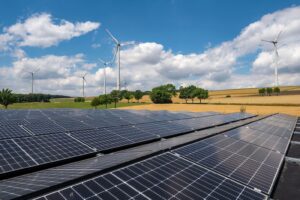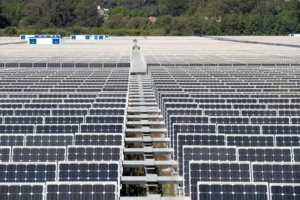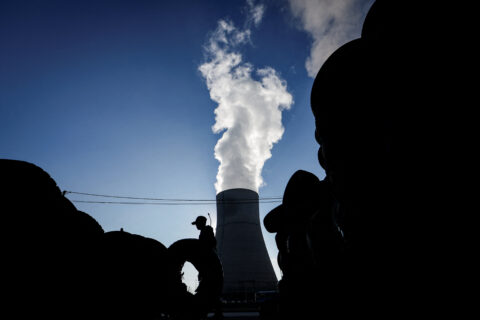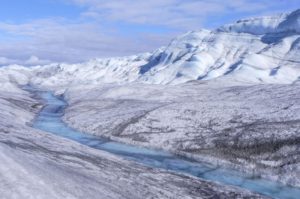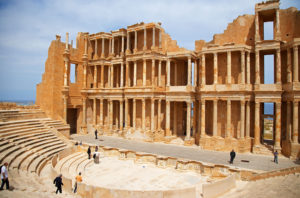Renewable energy will overtake coal to become the world’s top source of electricity “by 2026 at the latest”, according to new forecasts from the International Energy Agency (IEA).
The rise of renewables is being driven by extremely rapid growth in wind and solar output, which topped 4,000 terawatt hours (TWh) in 2024 and will pass 6,000TWh by 2026.
Wind and solar are increasingly under attack from populist politicians on the right, such as US president Donald Trump and Reform in the UK.
Nevertheless, they will together meet more than 90% of the increase in global electricity demand out to 2026, the IEA says, while modest growth for hydro power will add to renewables’ rise.
With nuclear and gas also reaching record highs by 2026, coal-fired generation is set to decline – driven by falls in China and the EU – meaning that power-sector emissions will decline, too.
The chart below illustrates these profound shifts in the global electricity mix – in particular, the meteoric rise of renewables, driven by wind and solar.
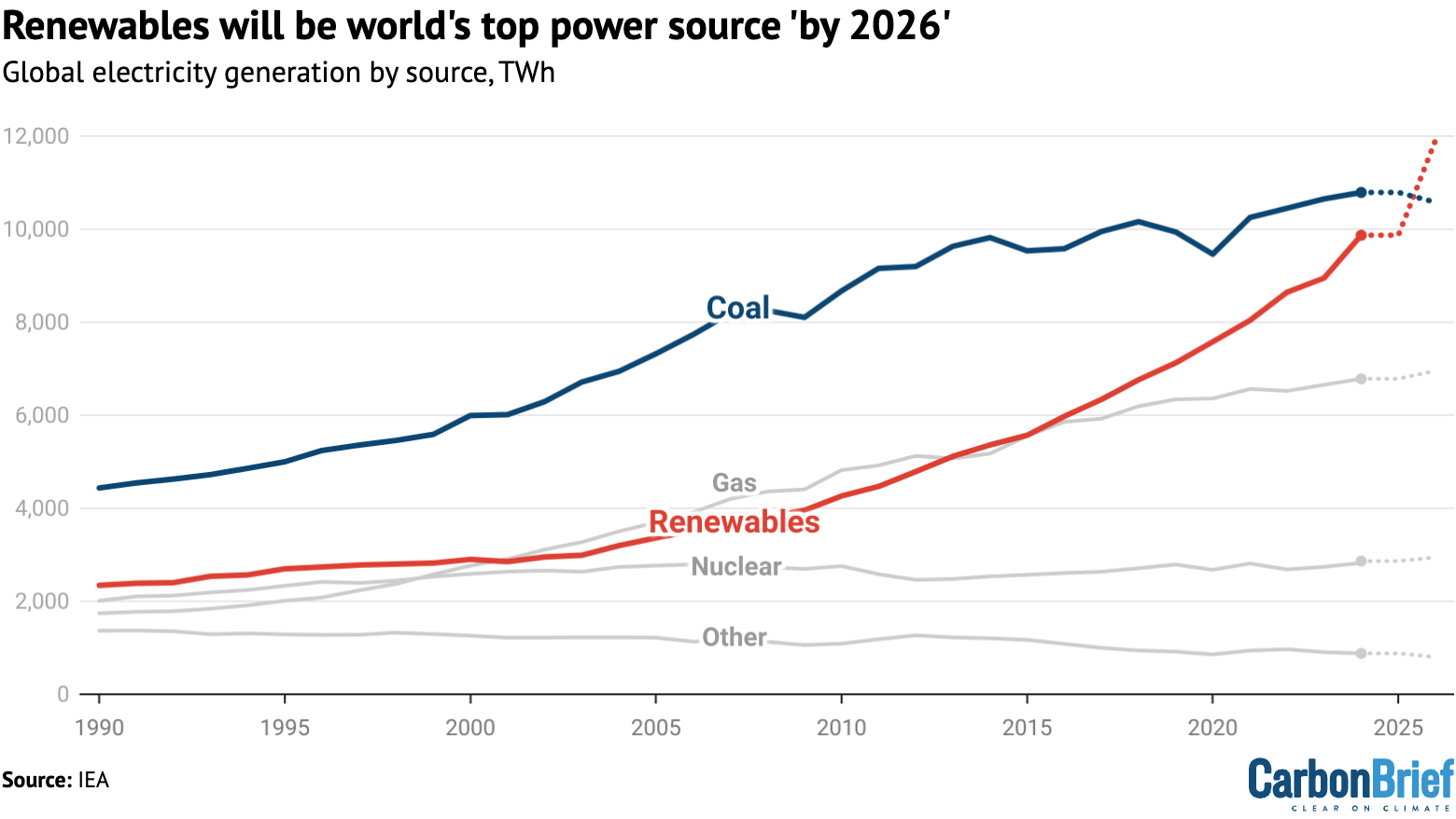
The IEA says that renewables could overtake coal as early as this year, depending on weather-related impacts on the output of wind and hydro capacity.
It adds that the switch will happen by 2026 “at the latest”, when renewables are expected to make up 36% of global power supplies, against just 32% from coal – the fuel’s lowest share in a century.
The share of global electricity generation coming from wind and solar combined will rise from 1% in 2005 and 4% in 2015 to 15% in 2024, 17% in 2025 and nearly 20% in 2026.
The global reduction in coal-fired electricity generation will result from declines in China and the EU, which will only be partially offset by increases in the US, India and other Asian nations.
The IEA attributes the coming decline of coal to “continued renewables growth and higher coal-to-gas switching in multiple regions”. It says gas power will rise by 1.3% this year and next.
For nuclear, the IEA says that the new record output will result from plant restarts in Japan, “robust” output in France and the US, as well as new reactors in China, India and South Korea.
The shift to wind and solar is happening despite global electricity demand being forecast to grow much faster over the next two years – at 3.3% and 3.7%, respectively – than the 2.6% average for 2015-2023.
The IEA says new demand is coming from industry, domestic appliances, growing use of air conditioning, ongoing electrification of heat and transport, as well as the expansion of data centres.
The post IEA: Renewables will be world’s top power source ‘by 2026’ appeared first on Carbon Brief.
Climate Change
Tanzania pushed African nations to oppose fossil fuel transition at COP30
Tanzania, a fossil gas producer that led African nations at COP30, urged African ministers to position themselves against transitioning away from fossil fuels ahead of critical negotiations in the final week of the summit, according to a document seen by Climate Home News.
The recommendation was part of a four-page presentation dated November 15 – the halfway point of COP30 – and delivered by Tanzania’s lead negotiator during a briefing on the just transition work programme as calls for the inclusion of a fossil fuel roadmap in the conference’s main outcome were gathering speed.
The powerpoint advised African countries to maintain a position against transitioning away from fossil fuels, while also ensuring that a call for universal energy access was included in the text.
Richard Muyungi – who chaired the 54-strong African group of countries at COP30 – told Climate Home News on November 14 that the group had yet to coordinate their views on a potential fossil fuel transition roadmap, but would do so if developments at COP30 required it. He added that Africa should not be forced or pushed towards a trajectory that threatens to undermine its development agenda.
Nonetheless, two African countries publicly stated during COP30 that they supported a transition roadmap, suggesting that they did not agree with the approach proposed by the African Group. A formal group position was not declared openly during the summit.
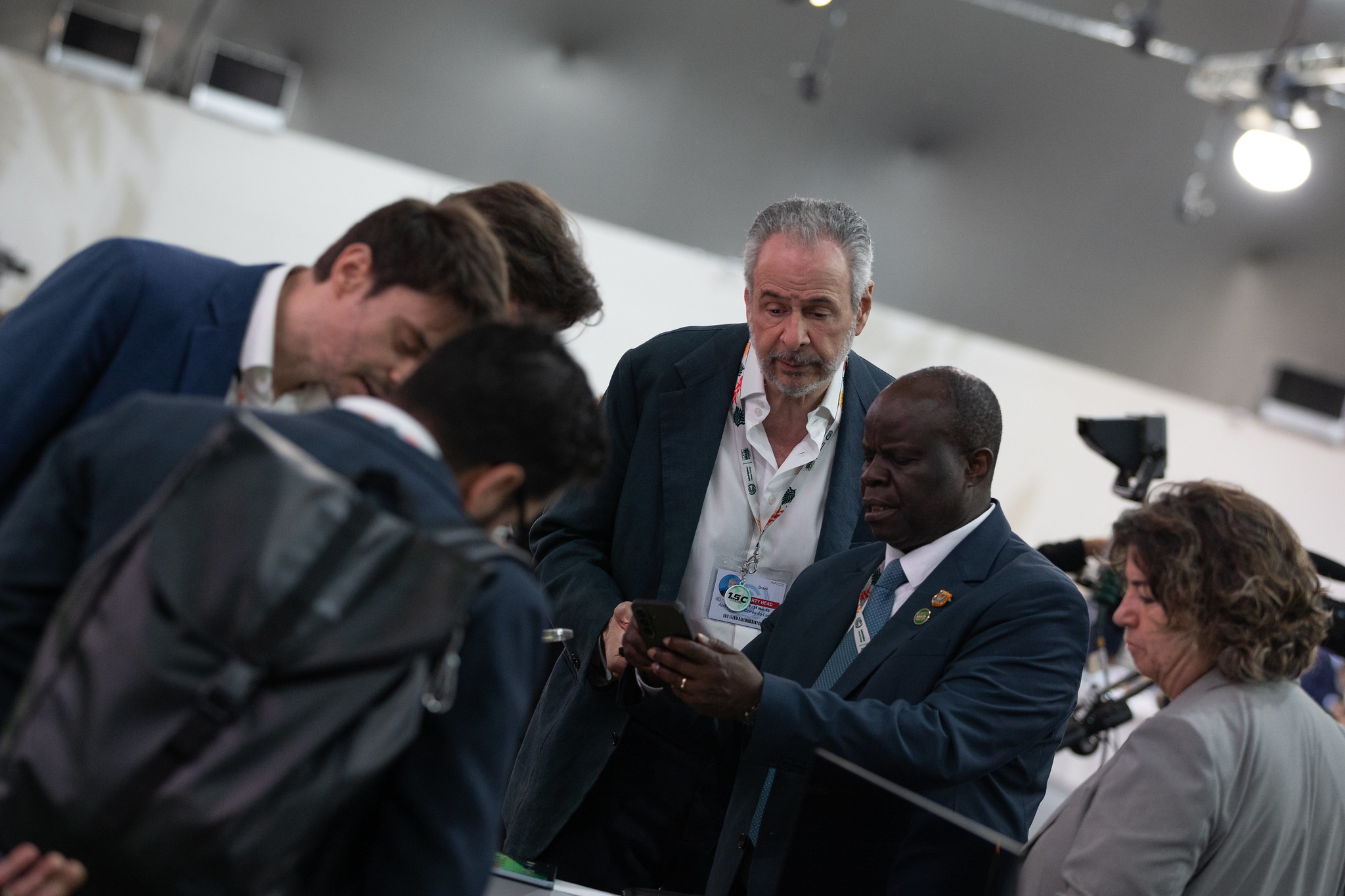

“Pathetic” to tell Africa to transition
Explicit references to phasing out fossil fuels were axed from the final “Global Mutirão” decision in the Belém “political package”, following strong pushback from oil and gas-producing nations led by Gulf states. But questions remained over the role of African countries, with The Guardian suggesting that Tanzania’s Richard Muyungi, chair of the African Group of Negotiators (AGN), told a closed-door meeting that the continent’s 54 countries aligned with Arab Group nations on the issue.
Muyungi did not confirm this alignment publicly, telling Climate Home News that the AGN had not been consulted by the COP30 presidency on fossil fuels. He added that, as many African nations have only just started tapping their oil and gas reserves, “how do you tell them to transition away when they have just discovered it [fossil fuel]?”
The AGN chair stressed that what Africa needs is energy access for the over 600 million people who currently lack electricity and 900 million others without clean cooking. He added that it would “really be pathetic” if Africa were told by other countries to transition away from fossil fuels. “Ours is a transition away from wood and charcoal to electricity,” he said.
Tanzania boasts vast gas reserves, some of which are expected to be auctioned off in a long-awaited new licensing round, and relies on the fossil fuel for over two-thirds of its electricity. Tanzania is also involved in the controversial 1,443-kilometer East African Crude Oil Pipeline (EACOP), which aims to carry crude oil extracted from fields under development near Uganda’s Lake Albert to the Tanga port in Tanzania for export to international markets.
Muyungi said the continent could get cheap electricity from gas and “nobody can tell us to transition away from gas because this is our survival now”.
“Our economy will not move if somebody tells us to move away from gas because it is part of the fossil fuels – we cannot accept [that],” he told Climate Home News.
African nations split over fossil fuel roadmap
Before negotiations kicked off in Belém, some African leaders called for careful consideration of any attempt to transition away from fossil fuels. Ghana’s environment minister Emmanuel Armah-Kofi Buah said that “to deny Africa the strategic use of these [natural] resources is to deny our right to develop, to light our homes and to power industries”.
As the idea of a fossil fuel transition roadmap unexpectedly became a priority for the COP30 talks following strong calls by Brazil’s president and environment minister, the divergent positions of African nations started to surface, making it hard for them to form a common stance.
Kenya and Sierra Leone, which overwhelmingly rely on clean energy sources, publicly supported the roadmap, joining a group of more than 80 countries to call for its inclusion in the final Mutirao decision.


Speaking at a press conference two days before the close of COP30, Jiwoh Abdulai, Sierra Leone’s minister of environment and climate change, said moving away from fossil fuels is not just a climate issue but an economic issue.
“We need to treat this with urgency, moving away from fossil fuels that are driving the increase in temperature,” he said, adding that “it has to be just and equitable especially for countries in Africa”.
Nigeria, Africa’s largest oil producer, took a more critical stance, saying it would not support any process that would lead to its “sudden economic contraction and heightened social instability”. In a speech during the closing plenary, a Nigerian government official said “a successful transition cannot be imposed” but should be a deliberate process that is nationally determined and supported by international cooperation.
Missed opportunity for Africa
While the final Mutirao decision did not reference fossil fuel transition roadmaps in any form, the Brazilian presidency promised to create a voluntary one outside of the UN climate process over the next year. The process is expected to gain support from other countries such as Colombia, which will host the first conference on the issue in April.
“We know some of you had greater ambition for some of the issues at hand,” COP30 president André Corrêa do Lago told the COP30closing plenary. “I will try not to disappoint you.”
Experts said that, by not coming out in support of the fossil fuel roadmap, most African countries missed an opportunity to bring their energy access and finance demands into the centre of the talks.
Tengi George-Ikoli, Nigeria manager at the Natural Resource Governance Institute (NRGI), said that rather than seeing it as a risk, Africa could have leveraged the opportunity to shape how the transition unfolds and ensure it does not happen in a way “that could cause more economic instability”, but is made into “a global pathway that is equitable, inclusive, and just”.
But the lack of collaboration around a roadmap meant that Africa lost a chance “for that collective voice” to influence a pathway that considers energy access needs, market volatility, and the vulnerability of oil-dependent economies, she said.
Finance at the centre
The scepticism around the roadmap resulted from a lack of clarity, one observer who asked for anonymity told Climate Home News. He said African nations saw the roadmap as a Brazilian initiative that they first came across in Belém, so “there was limited understanding of what this roadmap was about”.
NRGI’s George-Ikoli said that, while it was not clear what the roadmap would entail, African countries became more fixated on that instead of recognising the opportunity. “We might have gone too far into thinking that this roadmap may not be good for us and interpreting it to mean a number of things, not recognising that there’s an opportunity we can leverage now if we’re keen at the start and demand strongly.”
Financial and technological support must be at the centre of this, Sierra Leonean minister Abdulai said. He noted that Africa still needs to grow its economies but also wants to be part of the climate solution because “to us, climate action and economic growth are not mutually exclusive”.
The anonymous observer echoed the same, saying “any roadmap without finance will just remain a roadmap to nowhere”, adding that African countries also did not want to commit to something that they are not going to be able to afford to implement.
Seble Samuel, head of Africa campaigns and advocacy at the Fossil Fuel Non-Proliferation Treaty Initiative, said any roadmap needs to have clear accountability measures so that “it is not a smokescreen for continued failures on the means of implementation [finance]”. “That ultimately gaslights the Global South, especially those facing the biggest barriers to transition – like African nations,” she added.
George-Ikoli said Africa “can still leverage” the COP30 presidency roadmap to define, on their own terms, what a just transition must look like.
The coming year, she added, must be used to build a collective African position so the continent arrives at the next COP prepared and ready “to place its issues heightened on the agenda”.
The post Tanzania pushed African nations to oppose fossil fuel transition at COP30 appeared first on Climate Home News.
Tanzania pushed African nations to oppose fossil fuel transition at COP30
Climate Change
Asia-Pacific faces ‘$500bn-a-year’ hit from rising seas if current policies continue
Coastal flooding could bring $500bn of annual damages to the Asia-Pacific by the year 2100, if countries do not adapt to rising sea levels.
This is according to new research, published in the journal Scientific Reports, which assesses how coastal flooding is impacting the Asia-Pacific region – and models how the damages could worsen as sea level rises over the 21st century.
The paper finds that coastal flooding is already driving $26.8bn of damage every year across 29 countries in Asia and the Pacific, equivalent to 0.1% of the region’s GDP.
It projects that, under current policies, annual coastal flood damages in the region could rise to $518bn by 2100 – but this could drop to $338bn if warming is capped at 1.5C.
Small island states face the greatest risks from coastal flooding and will continue to bear the brunt of the damage as the planet continues to warm, according to the research.
For example, it finds that Tuvalu will face annual coastal flood damage equivalent to 38% of its GDP by the end of the century.
Meanwhile, small island states such as Kiribati, the Maldives, Micronesia and Tuvalu will permanently lose around 10% of their total land area.
The study’s lead author says the research shows how “rising seas” create “existential” and “economic” risks for low-lying islands in the Asia-Pacific.
He tells Carbon Brief that the paper highlights a “sharp inequality”, as developing nations with little historical responsibility for sea level rise face the brunt of its impacts.
Coastal damage
More than one billion people – about 15% of the world’s population – currently live within 10km of a coast.
Asia is home to some of the largest cities in the world, many of which are located near the sea, such as Mumbai, Tokyo, and Shanghai. The continent is home to 60% of the world’s coastal population.
However, there are hazards to living near the water.
Coastal flooding is caused by a combination of gradually rising sea levels and “episodic extreme sea levels”, such as high tides and storm surges, the study explains.
To assess these two factors, the study combines components including an ocean model and tide-height data.
The authors model flooding in all coastal Pacific and Asian countries that are listed as “developing member countries” by the Asian Development Bank. These 29 countries include Bangladesh, the Philippines and Tuvalu.
They calculate the economic damage caused by flooding, by combining their flood model with data on land use and “asset values” across the residential, commercial, industrial, infrastructure and agricultural sectors.
The authors assume when land floods permanently, the “assets” are completely lost. For areas that only flood periodically, the authors use a model linking flood depth to a percentage of land damaged to calculate the economic consequences.
They find that coastal flooding currently drives $27bn of damage every year in the Asia-Pacific.
China and Indonesia bear the greatest damage, each losing more than $6bn every year. The study authors say this is because both countries have “extensive coastlines, large populations in flood-prone areas and critical economic infrastructure concentrated near the coast”.
However, the study finds that small islands face the greatest economic damage as a percentage of their GDP.
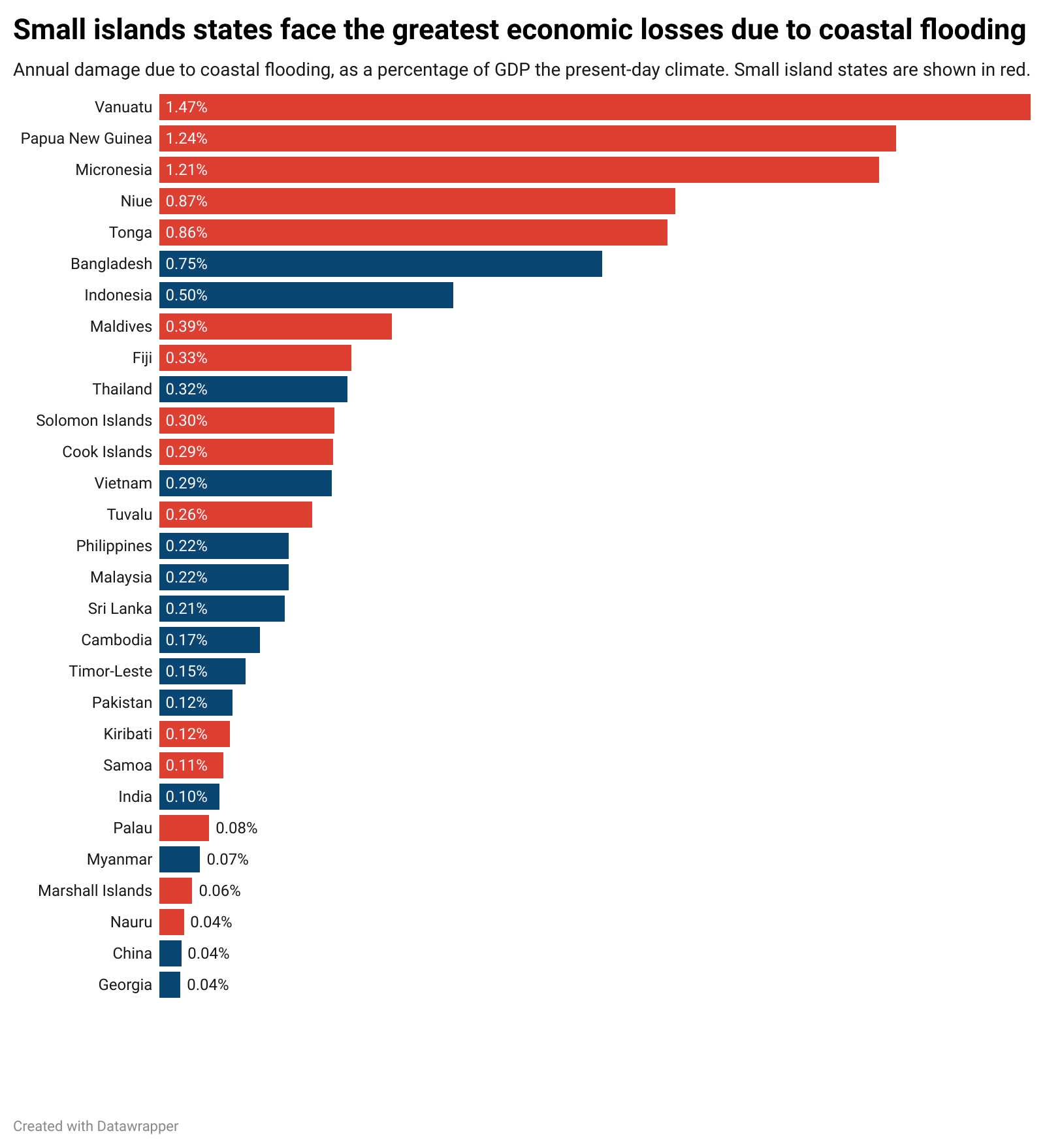
The study shows that the five most-severely affected countries are small island states. Vanuatu tops the ranking, losing 1.5% of its GDP to flooding every year. It is followed by Papua New Guinea and Micronesia.
Dr Michalis Vousdoukas is a researcher in coastal geography at the University of the Aegean in Greece and lead author of the study.
He tells Carbon Brief that even these damage estimates are “conservative” as they do not consider indirect economic losses, such as disruption to business, the loss of critical infrastructure, such as airports, or social impacts, such as migration.
Vousdoukas tells Carbon Brief that the study “highlights a sharp inequality between responsibility and impact”, explaining that the “countries that contributed the least to global emissions, particularly atoll nations, face the highest relative damages”.
Island nations in the Asia-Pacific region made of atolls – ring-shaped coral reefs or islands – include Kiribati, the Marshall Islands and Tuvalu.
Exposure
The authors also calculate population exposure to flooding, by overlaying their flood model with world population data.
Vousdoukas explains that “a person is considered exposed if they live in an area that appears as flooded in our model”.
The paper finds that six million people across the Asia-Pacific are currently at risk of coastal flooding each year, accounting for 0.2% of the region’s total population. The paper says:
“Although this may appear to be a small percentage, it still represents millions of individuals and families whose lives and livelihoods are under constant threat.”
Ranjan Panda is the convenor of the Combat Climate Change Network in India. Panda, who was not involved in the study, tells Carbon Brief that sea level rise is already forcing “millions of people to migrate out in distressed conditions to cities and other countries”.
China and Bangladesh rank the highest, with 2.2 million and 1.5 million people, respectively, exposed to coastal flooding each year.
However, small islands have the greatest percentage of their population exposed to flooding. Vanuatu again tops the table, with 2% of its population facing coastal flooding every year, according to the study. It is followed by Micronesia and the Maldives.
Bangladesh is the highest ranking non-island country, due to its “densely populated and flood-prone delta region”, the study finds.
Rising seas
As the climate warms, coastal flooding is worsening.
Average global sea levels have risen by more than 20cm since 1900, driven mainly by the thermal expansion of the ocean and the melting of glaciers and ice sheets.
Global warming is also “supercharging” hurricanes and typhoons, causing storm surges – the temporary rise in sea level that happens during a storm – to become more intense.
The study uses projections from the IPCC’s sixth assessment report to model sea level rise over the 21st century. These include thermal expansion and meltwater from glaciers and ice sheets, but exclude “low-likelihood, high-impact” events, such as ice-sheet collapse.
The authors assess five future scenarios:
- SSP1-1.9: A very-low emissions reductions pathway that “aligns with” the Paris Agreement’s 1.5C limit
- SSP1-2.6: A “low” emissions pathway achieving net-zero emissions after 2050
- SSP2-4.5: A “moderate” emissions scenario, often described as the trajectory under current climate policies.
- SSP3-7.0: A “high” emissions pathway
- SSP5-8.5: A very-high emissions pathway of “high fossil fuel reliance” throughout the 21st century
They find that, even under the lowest 1.5C warming scenario, countries in the Asia-Pacific will face damages of $338bn due to coastal flooding every year by the end of the century. This accounts for 1.3% of the region’s present-day GDP. (The authors assume no adaptation measures, changes in land use or inflation over the century.)
Under the current policy scenario, annual damage from coastal flooding rises to $518bn by the end of the century.
The chart below shows coastal flood damage as a percentage of annual GDP by the end of the century under the five scenarios for each country. Each horizontal bar shows the damage for one country, with the lowest warming SSP1-1.9 scenario on the left (grey) and highest warming SSP5-8.5 scenario (black) on the right.

The study finds that, by the end of the century, the Pacific island of Tuvalu will face the worst economic consequences from coastal flooding. Even under the 1.5C warming scenario, its annual economic losses due to coastal flooding will reach 38% of its GDP.
The authors also assess the amount of land that will be permanently lost to the sea.
They find that small island states – such as Kiribati, the Maldives, Micronesia and Tuvalu – will experience the highest percentage of their land permanently submerged, each losing around 10% of their total land area.
Two million people currently live in areas of the Asia-Pacific that will be permanently flooded by the end of the century under the 1.5C warming scenario, according to the research.
Finance gap
Countries can reduce the impacts of coastal flooding through adaptation. This can include building flood defenses, making infrastructure more resilient to flooding, or arranging “managed retreat” to move people away from vulnerable areas as the seas encroach.
The study authors model the cost of building defences – such as sea walls, levees, embankments and sand dunes – high enough that the economic damage from coastal flooding over the 21st century does not worsen beyond 2020 levels.
The research highlights that the cost of investing in these defences is substantially lower than the potential economic damages of sea level rise.
The authors estimate that, under a 1.5C warming scenario, building flood defenses to limit flood damage to 2020 levels would cost $9bn in total. However, building these defences would avoid $157bn in damages due to coastal flooding, they find.
Dr Rafael Almar is a researcher at the Laboratory of Space Geophysical and Oceanographic Studies in France and was not involved in the study. He says the study has “significant implications for development banks and financial institutions” as it could help them prioritise investments in “clearly identified hotspots”.
However, he emphasises that building flood defences “is not the only solution”. For example, he argues that “relocation and renaturalisation” – the process of moving people away from the coast and allowing the area to return to its natural state – can make an area “more resilient”.
Panda also warns that physical flood defenses “could actually be triggering further local environmental crises that accelerate the losses and damages faced by people due to sea level rise and flooding impacts”.
Sea walls have been shown to damage wildlife – for example, blocking animals such as turtles from reaching parts of the beach – according to an article in Climate Home News. The piece adds that physical defenses are “inflexible” and “mainly benefit the rich and encourage risky building near the coast”.
Sourcing money for developing countries to adapt to the impacts of climate change is an ongoing talking point at international climate negotiations.
A group of developed nations, including much of Europe, the US and Japan, is obliged under the Paris Agreement to provide international “climate finance” to developing countries. This money can be used for both mitigation – reducing emissions to limit warming – and adaptation.
In 2023, developed nations provided $26bn in international adaptation finance to developing nations, according to a recent UN report. This is roughly the amount that Asia-Pacific countries currently lose every year due to coastal flooding alone.
The post Asia-Pacific faces ‘$500bn-a-year’ hit from rising seas if current policies continue appeared first on Carbon Brief.
Asia-Pacific faces ‘$500bn-a-year’ hit from rising seas if current policies continue
Climate Change
How Sumatra’s lost trees turned extreme rain into catastrophe
Ronny P Sasmita is a senior analyst at Indonesia Strategic and Economics Action Institution, a think-tank specialising in geopolitical and geoeconomic studies in Indonesia.
The devastation that has swept across Aceh, North Sumatra and West Sumatra in recent weeks has forced Indonesia to confront an uncomfortable truth. What unfolded was not only a natural disaster but a collision between an exceptional climatic cycle and a landscape steadily stripped of its natural defenses.
More than 600 people have now been confirmed dead in the country, more than four hundred remain missing, and entire communities have been torn apart by the force of water, mud, and debris that surged with little warning. The scenes have become tragically familiar, houses swallowed by landslides, rivers breaking their banks, villages buried under mud that once clung to forest roots no longer there.
This year’s climate pattern created the perfect storm. Meteorological agencies warned that an active monsoon phase combined with warm ocean temperatures would push rainfall to exceptional levels across western Indonesia.
With no COP30 roadmap, hopes of saving forests hinge on voluntary initiatives
A rare tropical storm then formed in the Malacca Strait, unleashing torrential rains and wind gusts for several days. The Malacca Strait is one of the least likely places on Earth for tropical cyclones to form, making this event an exceptional anomaly. What might have once been manageable seasonal extremes became lethal when these torrents met degraded catchments and eroded hillsides.
Heavy rain alone does not create walls of mud and logs crashing into villages, it is heavy rain falling on land that is no longer able to hold or absorb it. In many affected districts, people reported water arriving faster and more violently than anyone could remember, carrying with it an astonishing volume of uprooted trees and logs that locals insist did not come from natural forest fall alone.
Conveyor belts of timber
This is where public suspicion has grown. The floods across the three provinces did not just bring water, they brought evidence. Viral videos showed rivers transformed into conveyor belts of timber, beaches covered with logs, and bridges jammed with uprooted trunks.
Environmental groups quickly pointed to long standing problems of deforestation and illegal logging that weaken watersheds and destabilize slopes. Some officials at the local level echoed these concerns, noting that the amount of cut wood carried by the floods appeared far beyond what would be expected from natural tree fall.
While the national government has cautioned against drawing conclusions too quickly, insisting that investigations into the origins of the timber are underway, the visual evidence has only deepened public frustration. Communities living downstream know what an intact forest looks and behaves like during heavy rain, and they know what a damaged one unleashes.
Legal concessions worsen problem
Recent data reinforces the scale of the problem. Independent monitoring groups reported that Indonesia lost more than two hundred sixty thousand hectares of forest in 2024, with over ninety thousand hectares lost on the island of Sumatra alone. This level of annual loss places Indonesia among the world’s highest tropical deforestation hotspots. Although much of this deforestation occurred inside legal concessions, the ecological impact is no less severe.
When natural forest is cleared, whether for plantations, industry, or illicit timber extraction, the soil becomes exposed, drainage shifts, and slopes lose integrity. Even more troubling, authorities uncovered a major illegal logging operation in the Mentawai Islands in late 2025, seizing more than four thousand cubic meters of illicit timber. This suggests that illegal extraction remains alive in areas where oversight is weak and access is difficult.
Comment: Europe must defend its deforestation law – for forests, business and its reputation
Such practices hollow out forest structure in ways that are not always visible until disaster strikes. Government policy has played an ambiguous role in this trajectory. On one hand, Indonesia has made international commitments to curb deforestation and has deployed satellite based early warning systems to identify suspicious land clearing.
On the other hand, the expansion of legal concessions for agriculture, timber, and mining has allowed vast tracts of natural forest to be converted. Even when legal, these transitions often degrade watersheds and reduce the natural capacity of landscapes to regulate water.
Local governments, strapped for revenue and political support, frequently view concessions as economic lifelines, while enforcement against illegal operators remains uneven. The result is a patchwork of legal and illegal pressures that steadily erode ecological resilience.
Protecting forests is a safety issue
The tragedy in Sumatra marks a warning that can no longer be ignored. Climate variability is intensifying, rainfall extremes are becoming more frequent, and the combination of strong storms and weakened landscapes will make disasters deadlier if current trends continue.
Indonesia cannot control the monsoon, but it can control the health of its forests. Protecting the remaining natural forest in Sumatra is no longer simply an environmental issue, it has become a matter of public safety and national stability.
Norway pledges $3bn in boost for Brazil-led tropical forest fund
Looking forward, the government must take a sharper turn. Enforcement against illegal logging must be strengthened through transparent monitoring and community based surveillance in remote areas. The issuance of new concessions in sensitive watersheds should be paused while existing ones undergo ecological audits.
Local governments in Sumatra need sustained funding for reforestation and slope stabilization projects, not one off emergency responses. Finally, national and provincial authorities must collaborate to restore degraded catchments before the next extreme rainfall arrives.
Sumatra has paid an unbearable price for years of ecological neglect combined with a climate growing more volatile. The next disaster is a question of when, not if. Whether it becomes another national tragedy or a turning point will depend on how seriously Indonesia treats the forests that remain standing and the people living beneath them.
The post How Sumatra’s lost trees turned extreme rain into catastrophe appeared first on Climate Home News.
How Sumatra’s lost trees turned extreme rain into catastrophe
-
Climate Change4 months ago
Guest post: Why China is still building new coal – and when it might stop
-
Greenhouse Gases4 months ago
Guest post: Why China is still building new coal – and when it might stop
-
Climate Change2 years ago
Spanish-language misinformation on renewable energy spreads online, report shows
-

 Greenhouse Gases2 years ago
Greenhouse Gases2 years ago嘉宾来稿:满足中国增长的用电需求 光伏加储能“比新建煤电更实惠”
-
Climate Change Videos2 years ago
The toxic gas flares fuelling Nigeria’s climate change – BBC News
-

 Climate Change2 years ago
Climate Change2 years ago嘉宾来稿:满足中国增长的用电需求 光伏加储能“比新建煤电更实惠”
-

 Carbon Footprint2 years ago
Carbon Footprint2 years agoUS SEC’s Climate Disclosure Rules Spur Renewed Interest in Carbon Credits
-
Renewable Energy5 months ago
US Grid Strain, Possible Allete Sale

